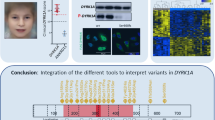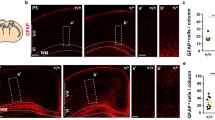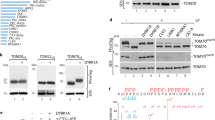Abstract
The dual-specificity tyrosine-phosphorylation-regulated kinase 1A (DYRK1A) gene, located on chromosome 21q22.13 within the Down syndrome critical region, has been implicated in syndromic intellectual disability associated with Down syndrome and autism. DYRK1A has a critical role in brain growth and development primarily by regulating cell proliferation, neurogenesis, neuronal plasticity and survival. Several patients have been reported with chromosome 21 aberrations such as partial monosomy, involving multiple genes including DYRK1A. In addition, seven other individuals have been described with chromosomal rearrangements, intragenic deletions or truncating mutations that disrupt specifically DYRK1A. Most of these patients have microcephaly and all have significant intellectual disability. In the present study, we report 10 unrelated individuals with DYRK1A-associated intellectual disability (ID) who display a recurrent pattern of clinical manifestations including primary or acquired microcephaly, ID ranging from mild to severe, speech delay or absence, seizures, autism, motor delay, deep-set eyes, poor feeding and poor weight gain. We identified unique truncating and non-synonymous mutations (three nonsense, four frameshift and two missense) in DYRK1A in nine patients and a large chromosomal deletion that encompassed DYRK1A in one patient. On the basis of increasing identification of mutations in DYRK1A, we suggest that this gene be considered potentially causative in patients presenting with ID, primary or acquired microcephaly, feeding problems and absent or delayed speech with or without seizures.
Similar content being viewed by others

Log in or create a free account to read this content
Gain free access to this article, as well as selected content from this journal and more on nature.com
or
References
van Bokhoven H : Genetic and epigenetic networks in intellectual disabilities. Annu Rev Genet 2011; 45: 81–104.
Srivastava AK, Schwartz CE : Intellectual disability and autism spectrum disorders: causal genes and molecular mechanisms. Neurosci Biobehav Rev 2014; 46: 161–174.
Lubs HA, Stevenson RE, Schwartz CE : Fragile X and X-linked intellectual disability: four decades of discovery. Am J Hum Genet 2012; 90: 579–590.
Bassani S, Zapata J, Gerosa L, Moretto E, Murru L, Passafaro M : The neurobiology of X-linked intellectual disability. Neuroscientist 2013; 19: 541–552.
Piton A, Redin C, Mandel JL : XLID-causing mutations and associated genes challenged in light of data from large-scale human exome sequencing. Am J Hum Genet 2013; 93: 368–383.
Gilissen C, Hehir-Kwa JY, Thung DT et al: Genome sequencing identifies major causes of severe intellectual disability. Nature 2014; 511: 344–347.
Henderson LB, Applegate CD, Wohler E, Sheridan MB, Hoover-Fong J, Batista DA : The impact of chromosomal microarray on clinical management: a retrospective analysis. Genet Med 2014; 16: 657–664.
Becker W, Sippl W : Activation, regulation, and inhibition of DYRK1A. FEBS J 2011; 278: 246–256.
Tejedor FJ, Hammerle B : MNB/DYRK1A as a multiple regulator of neuronal development. FEBS J 2011; 278: 223–235.
Wegiel J, Gong CX, Hwang YW : The role of DYRK1A in neurodegenerative diseases. FEBS J 2011; 278: 236–245.
Park J, Chung KC : New perspectives of Dyrk1A role in neurogenesis and neuropathologic features of Down syndrome. Exp Neurobiol 2013; 22: 244–248.
Guimera J, Casas C, Pucharcos C et al: A human homologue of Drosophila minibrain (MNB) is expressed in the neuronal regions affected in Down syndrome and maps to the critical region. Hum Mol Genet 1996; 5: 1305–1310.
Galceran J, de Graaf K, Tejedor FJ, Becker W : The MNB/DYRK1A protein kinase: genetic and biochemical properties. J Neural Transm Suppl 2003; 139–148.
Hammerle B, Elizalde C, Tejedor FJ : The spatio-temporal and subcellular expression of the candidate Down syndrome gene Mnb/Dyrk1A in the developing mouse brain suggests distinct sequential roles in neuronal development. Eur J Neurosci 2008; 27: 1061–1074.
Fernandez-Martinez J, Vela EM, Tora-Ponsioen M, Ocana OH, Nieto MA, Galceran J : Attenuation of Notch signalling by the Down-syndrome-associated kinase DYRK1A. J Cell Sci 2009; 122: 1574–1583.
Murakami N, Bolton DC, Kida E, Xie W, Hwang YW : Phosphorylation by Dyrk1A of clathrin coated vesicle-associated proteins: identification of the substrate proteins and the effects of phosphorylation. PLoS One 2012; 7: e34845.
Barallobre MJ, Perier C, Bove J et al: DYRK1A promotes dopaminergic neuron survival in the developing brain and in a mouse model of Parkinson's disease. Cell Death Dis 2014; 5: e1289.
Tejedor F, Zhu XR, Kaltenbach E et al: Minibrain: a new protein kinase family involved in postembryonic neurogenesis in Drosophila. Neuron 1995; 14: 287–301.
Fotaki V, Dierssen M, Alcantara S et al: Dyrk1A haploinsufficiency affects viability and causes developmental delay and abnormal brain morphology in mice. Mol Cell Biol 2002; 22: 6636–6647.
Fotaki V, Martinez De Lagran M, Estivill X, Arbones M, Dierssen M : Haploinsufficiency of Dyrk1A in mice leads to specific alterations in the development and regulation of motor activity. Behav Neurosci 2004; 118: 815–821.
Arque G, Fotaki V, Fernandez D, Martinez de Lagran M, Arbones ML, Dierssen M : Impaired spatial learning strategies and novel object recognition in mice haploinsufficient for the dual specificity tyrosine-regulated kinase-1A (Dyrk1A). PLoS One 2008; 3: e2575.
Moller RS, Kubart S, Hoeltzenbein M et al: Truncation of the Down syndrome candidate gene DYRK1A in two unrelated patients with microcephaly. Am J Hum Genet 2008; 82: 1165–1170.
Oegema R, de Klein A, Verkerk AJ et al: Distinctive phenotypic abnormalities associated with submicroscopic 21q22 deletion including DYRK1A. Mol Syndromol 2010; 1: 113–120.
Fujita H, Torii C, Kosaki R et al: Microdeletion of the Down syndrome critical region at 21q22. Am J Med Genet A 2010; 152A: 950–953.
Yamamoto T, Shimojima K, Nishizawa T, Matsuo M, Ito M, Imai K : Clinical manifestations of the deletion of Down syndrome critical region including DYRK1A and KCNJ6. Am J Med Genet A 2011; 155A: 113–119.
Valetto A, Orsini A, Bertini V et al: Molecular cytogenetic characterization of an interstitial deletion of chromosome 21 (21q22.13q22.3) in a patient with dysmorphic features, intellectual disability and severe generalized epilepsy. Eur J Med Genet 2012; 55: 362–366.
van Bon BW, Hoischen A, Hehir-Kwa J et al: Intragenic deletion in DYRK1A leads to mental retardation and primary microcephaly. Clin Genet 2011; 79: 296–299.
Courcet JB, Faivre L, Malzac P et al: The DYRK1A gene is a cause of syndromic intellectual disability with severe microcephaly and epilepsy. J Med Genet 2012; 49: 731–736.
O'Roak BJ, Vives L, Fu W et al: Multiplex targeted sequencing identifies recurrently mutated genes in autism spectrum disorders. Science 2012; 338: 1619–1622.
O'Roak BJ, Vives L, Girirajan S et al: Sporadic autism exomes reveal a highly interconnected protein network of de novo mutations. Nature 2012; 485: 246–250.
Iossifov I, Ronemus M, Levy D et al: De novo gene disruptions in children on the autistic spectrum. Neuron 2012; 74: 285–299.
Sherry ST, Ward MH, Kholodov M et al: dbSNP: the NCBI database of genetic variation. Nucleic Acids Res 2001; 29: 308–311.
1000 Genomes Project Consortium 1000 Genomes Project Consortium, Abecasis GR, Altshuler D et al: A map of human genome variation from population-scale sequencing. Nature 2010; 467: 1061–1073.
Adzhubei IA, Schmidt S, Peshkin L et al: A method and server for predicting damaging missense mutations. Nat Methods 2010; 7: 248–249.
Kumar P, Henikoff S, Ng PC : Predicting the effects of coding non-synonymous variants on protein function using the SIFT algorithm. Nat Protoc 2009; 4: 1073–1081.
Schwarz JM, Rodelsperger C, Schuelke M, Seelow D : MutationTaster evaluates disease-causing potential of sequence alterations. Nat Methods 2010; 7: 575–576.
Redin C, Le Gras S, Mhamdi O et al: Targeted high-throughput sequencing for diagnosis of genetically heterogeneous diseases: efficient mutation detection in Bardet-Biedl and Alstrom syndromes. J Med Genet 2012; 49: 502–512.
Li H, Durbin R : Fast and accurate long-read alignment with Burrows-Wheeler Transform. Bioinformatics 2010; 26: 589–595.
McKenna A, Hanna M, Banks E et al: The Genome Analysis Toolkit: a MapReduce framework for analyzing next-generation DNA sequencing data. Genome Res 2010; 20: 1297–1303.
Dalgleish R, Flicek P, Cunningham F et al: Locus Reference Genomic sequences: an improved basis for describing human DNA variants. Genome Med 2010; 2: 24.
Ashwal S, Michelson D, Plawner L, Dobyns WB : Quality Standards Subcommittee of the American Academy of Neurology and the Practice Committee of the Child Neurology Society: Practice parameter: evaluation of children and adolescents with recurrent headaches: report of the Quality Standards Subcommittee of the American Academy of Neurology and the Practice Committee of the Child Neurology Society. Neurology 2009; 73: 887–897.
Himpel S, Panzer P, Eirmbter K et al: Identification of the autophosphorylation sites and characterization of their effects in the protein kinase DYRK1A. Biochem J 2001; 359: 497–505.
Wiechmann S, Czajkowska H, de Graaf K, Grotzinger J, Joost HG, Becker W : Unusual function of the activation loop in the protein kinase DYRK1A. Biochem Biophys Res Commun 2003; 302: 403–408.
Benavides-Piccione R, Dierssen M, Ballesteros-Yanez I et al: Alterations in the phenotype of neocortical pyramidal cells in the Dyrk1A+/− mouse. Neurobiol Dis 2005; 20: 115–122.
Guo X, Williams JG, Schug TT, Li X : DYRK1A and DYRK3 promote cell survival through phosphorylation and activation of SIRT1. J Biol Chem 2010; 285: 13223–13232.
Hammerle B, Ulin E, Guimera J, Becker W, Guillemot F, Tejedor FJ : Transient expression of Mnb/Dyrk1a couples cell cycle exit and differentiation of neuronal precursors by inducing p27KIP1 expression and suppressing NOTCH signaling. Development 2011; 138: 2543–2554.
Soppa U, Schumacher J, Florencio Ortiz V, Pasqualon T, Tejedor FJ, Becker W : The Down syndrome-related protein kinase DYRK1A phosphorylates p27(Kip1) and Cyclin D1 and induces cell cycle exit and neuronal differentiation. Cell Cycle 2014; 13: 2084–2100.
Scales TM, Lin S, Kraus M, Goold RG, Gordon-Weeks PR : Nonprimed and DYRK1A-primed GSK3 beta-phosphorylation sites on MAP1B regulate microtubule dynamics in growing axons. J Cell Sci 2009; 122: 2424–2435.
Martinez de Lagran M, Benavides-Piccione R, Ballesteros-Yanez I et al: Dyrk1A influences neuronal morphogenesis through regulation of cytoskeletal dynamics in mammalian cortical neurons. Cereb Cortex 2012; 22: 2867–2877.
Dowjat K, Adayev T, Kaczmarski W, Wegiel J, Hwang YW : Gene dosage-dependent association of DYRK1A with the cytoskeleton in the brain and lymphocytes of down syndrome patients. J Neuropathol Exp Neurol 2012; 71: 1100–1112.
Hong SH, Lee KS, Kwak SJ et al: Minibrain/Dyrk1a regulates food intake through the Sir2-FOXO-sNPF/NPY pathway in Drosophila and mammals. PLoS Genet 2012; 8: e1002857.
Kent WJ, Sugnet CW, Furey TS et al: The human genome browser at UCSC. Genome Res 2002; 12: 996–1006.
Acknowledgements
The authors thank the parents for consenting to the clinical and molecular studies and presentation of these findings. The authors also thank the international consortium of clinical and laboratory personnel involved in carrying out these studies. Partial support was provided by the South Carolina Department of Disability and Special Needs and the Greenwood Genetic Center Foundation, and by grants from Fondation Jerome Lejeune, Agence de Biomedecine and CREGEMES to the Strasbourg team.
Author information
Authors and Affiliations
Corresponding author
Ethics declarations
Competing interests
The authors declare no conflict of interest.
Additional information
Supplementary Information accompanies this paper on European Journal of Human Genetics website
Supplementary information
Rights and permissions
About this article
Cite this article
Bronicki, L., Redin, C., Drunat, S. et al. Ten new cases further delineate the syndromic intellectual disability phenotype caused by mutations in DYRK1A. Eur J Hum Genet 23, 1482–1487 (2015). https://doi.org/10.1038/ejhg.2015.29
Received:
Revised:
Accepted:
Published:
Issue date:
DOI: https://doi.org/10.1038/ejhg.2015.29
This article is cited by
-
Clinical course of epilepsy and white matter abnormality linked to a novel DYRK1A variant
Human Genome Variation (2021)
-
The nuclear interactome of DYRK1A reveals a functional role in DNA damage repair
Scientific Reports (2019)
-
Autism-associated Dyrk1a truncation mutants impair neuronal dendritic and spine growth and interfere with postnatal cortical development
Molecular Psychiatry (2018)
-
Clinical phenotype of ASD-associated DYRK1A haploinsufficiency
Molecular Autism (2017)
-
Zebrafish knockout of Down syndrome gene, DYRK1A, shows social impairments relevant to autism
Molecular Autism (2017)


